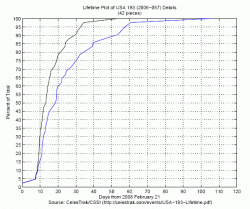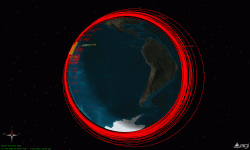The shoot down of US spy satellite USA 193 was condemned by some quarters of the international community. However, the fact remains, this was a resounding success for the US military. Observers of the operation to destroy the potentially dangerous satellite likened it to “trying to fire a missile through the eye of a needle”. After all, the dead satellite was orbiting at a height of about 250 km, and the satellite-killing missile was fired from a boat; assuring impact with an object the size of a small bus was never going to be easy. But the mission was a success and the satellite disintegrated into bits (no bigger than a football). Now the task of tracking the debris is under way, and the fallout from last months fireworks are impacting the scheduled launch of other space missions…
According to CelesTrak, there are 52 catalogued bits of USA 193 orbiting the Earth. The pieces range in altitude from 167 km (at the closest approach) to over 2,600 km (at apogee – the highest point of orbit) and they are being tracked with great accuracy (pictured above).

The 5,000 pound (2,300 kg) satellite apparently disintegrated into many small pieces of debris, each no bigger than the volume of a football (equivalent to a circle with a diameter of 20 cm). Anything smaller than 10 cm cannot be tracked with any degree of accuracy, so an analysis by CelesTrak (pictured left) shows the upper and lower bounds of debris that can be tracked and how long they are likely to stay in orbit.
As a rule, larger pieces of debris will remain in orbit for longer, whilst the smaller objects will have less momentum to stay above the Earths atmosphere. As can be seen, most of the debris can be expected to burn up through atmospheric re-entry within 30 days, but there is a massive difference in the lifetime of the remaining 10 cm debris when compared with the 20 cm debris. The remaining 5% of large chunks of satellite are projected to stay in orbit for 50 days longer than their smaller cousins.
Tracking these bits of debris is an arduous task, but the monitoring continues. The destruction of USA 193 has influenced the scheduled launch of rockets since February 20th, and disruption is likely to continue should these larger pieces of debris pass through spacecraft launch windows. The launch of a US National Reconnaissance Office NROL-28 reconnaissance satellite last Friday from Vandenberg Air Force Base in California, has been postponed for two weeks until the USA 193 debris poses no threat of collision.
Universe Today coverage of the demise of satellite USA 193:
- US Cruiser Strikes Dead Spy Satellite
- US Planning to Shoot Down Dead Spy Satellite
- US Spy Satellite Could Crash To Earth In February
Original Source: CelesTrak


When will we learn you can’t clear the garbage using handgrenades…. you need to use a “dustpan and broom”, else we are going to see ourselves locked in here with no satalites (read no modern culture), till mother (nature) cleans up for us in a few decades. Are we realy that badly spolt brats
-> Graham: The problem of long-lived debris is true for the Chinese downing of a bird in January 2007, not for this one. Read the article again!
Doesn’t the perfection of this ability mean that we can count on the destruction of every sattelite up there in the event of a war or the threat of one making somebody a little nervous? We supplied Saddam-Hussein sattelite information on Iranian troop deployments during their war. What would keep a country so threatened by third nation interference (like us) from eliminating that threat? And who could blame them?
Sorry folks, ain’t nothing new about this. I worked on classified ASAT [anti-satellite] programs back in the early 80s and we developed this “flying brick” capability back then. We just never used it on a live target thanks to the cowardice of the US Congress. Our tests were to theoretical “points in space.”
http://celestrak.com/cgi-bin/searchSOCRATES.pl?IDENT=NAME&NAME_TEXT=usa%20193%20deb&ORDER=MINRANGE&MAX=250
Many satellites continue to be endangered. See the list. .98KM is MUCH too close.
This event endangered ALL of the satellites in LEO.
http://celestrak.com/events/usa-193.asp
The risk to satellites from the Chinese debris is MUCH WORSE.
http://celestrak.com/cgi-bin/searchSOCRATES.pl?IDENT=NAME&NAME_TEXT=FENGYUN%201C%20DEB&ORDER=MINRANGE&MAX=4000
Our satelites are vulnerable to our own star’s whims. A massive ejection directed at Earth will probably disable most communication satellites.
How will we cleanup the mess then?
We need to have a system of garbage collection & disposal.
Ahh!
Maybe the Mafia will be interested?
There will certainly be a lot of money to be made.
Any Ideas on how this could be done?
There are still 16 trackable (bigger than 10 cm) pieces up.
you may watch the development and their position here: http://thomas-wehr.homeip.net/space/earthview-special.php